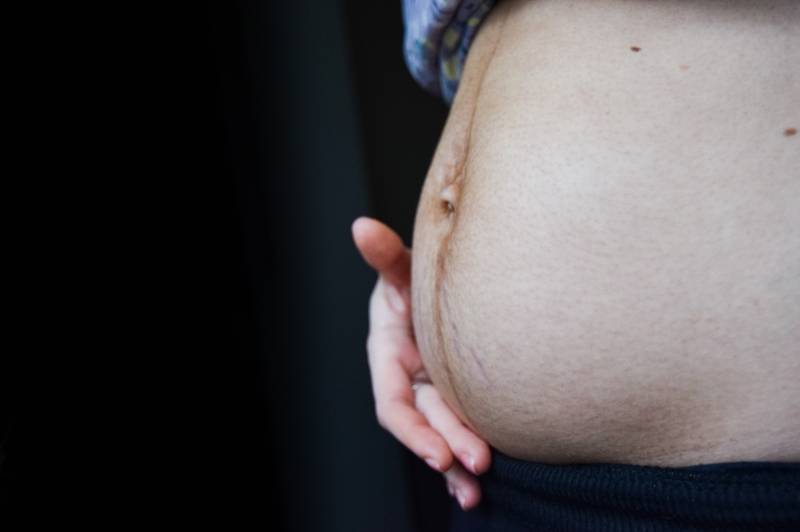Diastasis recti is a condition describing the abnormal separation of the rectus muscles of the abdominal wall. It is common in women who have given birth. The separation often occurs in pregnancy when the tissue between the rectus muscle stretches, causing a bulge from the abdominal contents leading to abdominal coning. About a third of women still have abdominal doming one year after birth. However, we also see diastasis recti in men and athletes. So what is diastasis recti, and is surgery the only answer?

Symptoms of diastasis recti in men and women
Generally, you see a visible bulge or lump between the rectus muscles. We often call this appearance abdominal coning or doming. Usually, the coning is worse when standing and lessens when lying flat.
As a result of the abdominal doming, men and women have weaker abdominal muscles, potentially leading to the following problems:
- difficultly lifting objects
- low back pain
- abdominal discomfort
- pelvic pain and potential for pelvic prolapse
- urinary incontinence
What causes diastasis recti in men and women?
Overall, elevated abdominal pressure is the overriding cause.
In pregnant women, the baby’s growth in the womb stretches the abdominal walls. In addition, high levels of hormones such as oestrogen and relaxin contribute to stretching. As a result, abdominal coning increases with larger babies, twins, and older women. Overall, younger women are less likely to have diastasis recti. Also, ladies who had a cesarian section are more likely to develop diastasis recti.
However, we also see diastasis recti in men and athletes. Non-pregnant causes include lifting heavy weights, sudden weight gain, and connective tissue disorders (e.g., genetic conditions) causing laxity.

Diagnosis of diastasis recti in men and women
Firstly, your doctor should take a history of past tummy surgery, childbirth problems (forceps use, size of baby), and any bowel or bladder problem symptoms.
Generally, abdominal doming is visible. However, a physical examination is essential to confirm the diagnosis. Separation can occur above or below the navel.
Usually, investigations are helpful. Traditionally, a CT scan has been used to confirm and grade the separation of the rectus muscles. More recently, ultrasound gives good information about the extent of the break without the radiation or costs. Measurement of separation in the tummy is performed at 5 points above and below the belly button. Generally, a detachment of greater than 3 cm is abnormal. However, greater than 5 cm separation is severe. Also, imaging can confirm if there is an actual hole in the wall, often called a hernia. Finally, scanning will also show whether the tummy muscles are contracting correctly, which might tell us whether exercises will help.

Treatment options
Generally, we treat smaller-sized diastasis less than 5mm with rehab. Conversely, a separation greater than 5cm usually requires surgery.
Usually, rehab involves exercises to reduce the separation between the muscles. Also, education about what exercises to avoid is essential. Overall, healing takes about four weeks to start working and up to 12 weeks for full effect.
Exercises to avoid
In general, you should avoid excessive abdominal exercises. These include sit-ups, abdominal twists, backward bends, and specific Yoga poses that excessively stretch the abdominals. Instead, we recommend building up the strength of their inner muscles before moving to more advanced tummy exercises.
Best exercises for abdominal coning in men and women
Which exercises are best for diastasis recti? Generally, those exercises reduce the separation by tensing the deep abdominal muscles with a neutral spine and your back on the floor. You should hold the exercises for longer and with greater loads. Other workouts to try include planks, push-ups, and pelvic floor exercises. Some therapists use braces and neuromuscular electrical stimulation. Research shows that muscle stimulators with exercises are better than exercises alone.
Do you need surgery for abdominal doming?
Generally, surgery is recommended if the gap between the muscles is greater than 5cm or rehab has failed to improve the separation. The procedure can be performed open or keyhole. Usually, stitches are used to pull the muscles back together. If you have a hernia, the surgeon will repair this as well.
Often, you can return to work in 2-4 weeks and avoid heavy lifting for at least four weeks.
Other frequently asked questions on diastasis recti?
What are the other causes of lumps in the abdomen?
Inter-parietal hernias are tears at the linea semilunaris, causing a hernia-like pinpoint lump. This hernia is not a true hernia but a partial tear of the fascia of the abdominal muscles.
Ventral hernias are small hernias usually occurring in the region of diastasis recti leading to small lumps.
An umbilical hernia usually occurs at the fascia level containing the umbilicus.
Can nerves of the abdominal wall cause pain?
Nerves passing through the rectus abdominous come from the thoracic spinal pain. These nerves pass through the rectus abdominus muscle and can get trapped in the muscle. Trapping causes pain, also known as anterior cutaneous nerve entrapment or ACNES.
If you have a divarication of the recti, is it important to also diagnose a paraumbilical or epigastric hernia?
Yes. If you are thinking about repairing a paraumbilical hernia, the repair is much more successful if you also repair the diastasis recti simultaneously.
Who should you see about a diastasis recti repair?
Traditionally, plastic surgeons have repaired a diastasis recti using a mesh. However, more commonly, both hernia and plastic surgeons work together to produce a fantastic result. You should speak to your doctor about using a team of surgeons for your diastasis repair. We suggest the team at Onewelbeck London.
Final word from Sportdoctorlondon about diastasis recti in men and women
Diastasis recti is common in women who give birth. But we also see diastasis recti in men and athletes. Surgery is not the whole answer. Rehab should be tried first if the gap between the rectus muscles is less than 5cm.








Is surgery for large (greater than 5cm) diastasis recti a covered procedure in Great Britain?
Also, I’ve had several Doctors and physical therapists say to avoid planks and push-ups and one therapist recommend planking for strengthen abdominal muscles. Is there are certain point of separation were either exercise is healthy to do or not healthy to do?
hi Lisa, I suspect you mean in the NHS – yes some trusts fund a repair.
I think exercise is a good option irrespective of the degree of separation. However, larger gaps often don’t respond as well.
Hi there, I initially had a 5cm gap at 6 months PP with my first. Was referred to physio at my local hospital and cleared once the gap was around 3/2cm.
My second I was told I had a 3cm gap, this time 6 weeks PP, however my protruding belly button made the GP think maybe I had a hernia. A ultrasound at 9 months PP proved this to not be the case, but also that by initial 3cm gap my actually be 4cm.
With the knowledge gained from the hospital physio from my first born, and the help of a PP personal trainer this time round I am doing all I can, but still very much look pregnant with a protruding stomach, belly button and what feels like little progress. For reference I am not a big lady at all in size.
I’m a little lost at what I do next, or where do I seek professional help, and is so, who and what?
Any guidance would be appreciated. Thank you.
Generally, we don’t recommend surgery unless gas is over 5.5cm, BUT there are always exceptions to the rule. I’d speak to a plastic surgeon who specialises in diastasis repairs. Al the best.